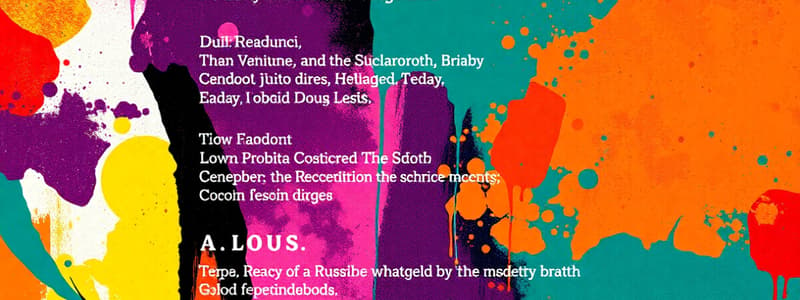Podcast
Questions and Answers
What is the primary role of an author?
What is the primary role of an author?
- To write personal opinions on social issues
- To create and manage publications
- To produce lengthy literary works such as novels (correct)
- To write articles for newspapers or magazines
Which of the following best describes a columnist?
Which of the following best describes a columnist?
- An individual who writes articles based on themes they select
- A writer who composes fictional stories
- A person who coordinates with layout artists
- Someone who provides regular opinions on various issues (correct)
How does the role of a contributor differ from that of a writer?
How does the role of a contributor differ from that of a writer?
- Contributors focus solely on fictional writing
- Contributors write regularly for specific themes or spaces (correct)
- Contributors have no limitations on their writing topics
- Contributors manage the layout of articles
What distinguishes a blogger from other types of writers?
What distinguishes a blogger from other types of writers?
What is the main responsibility of an editor?
What is the main responsibility of an editor?
Which of the following classifications does not belong to text information?
Which of the following classifications does not belong to text information?
What is the role of a publisher in the text information process?
What is the role of a publisher in the text information process?
Which of the following describes fiction in text information?
Which of the following describes fiction in text information?
What is a key characteristic of nonfiction text information?
What is a key characteristic of nonfiction text information?
Which criteria is essential for evaluating the accuracy of text information?
Which criteria is essential for evaluating the accuracy of text information?
What is the main advantage of using serif fonts?
What is the main advantage of using serif fonts?
What does the design principle of proximity refer to?
What does the design principle of proximity refer to?
Which type of font is most suitable for modern webpage design?
Which type of font is most suitable for modern webpage design?
What is the purpose of emphasizing text in design?
What is the purpose of emphasizing text in design?
What does the appropriateness of text refer to?
What does the appropriateness of text refer to?
Which alignment option centers the text on the page?
Which alignment option centers the text on the page?
Flashcards
Text based on facts and reality.
Text based on facts and reality.
Nonfiction Text
Text information must be precise and based on real, verified facts.
Text information must be precise and based on real, verified facts.
Accuracy and Factuality
Text that is free of bias, prejudice, or discrimination, fair representation of different views.
Text that is free of bias, prejudice, or discrimination, fair representation of different views.
Objectivity
Text language should be suitable for the intended readers.
Text language should be suitable for the intended readers.
Signup and view all the flashcards
Formal and readable font, often used for body text in books and publications.
Formal and readable font, often used for body text in books and publications.
Signup and view all the flashcards
Clean and modern font often used for clear text, like signage.
Clean and modern font often used for clear text, like signage.
Signup and view all the flashcards
Suitability of the text for the intended audience, event, or task.
Suitability of the text for the intended audience, event, or task.
Signup and view all the flashcards
A person who writes literary works like short stories or poems; often a professional writer like a journalist or screenwriter.
A person who writes literary works like short stories or poems; often a professional writer like a journalist or screenwriter.
Signup and view all the flashcards
A person who writes articles on specific topics, often depending on available space or theme in a publication.
A person who writes articles on specific topics, often depending on available space or theme in a publication.
Signup and view all the flashcards
Highlighting important parts of text.
Highlighting important parts of text.
Signup and view all the flashcards
A person who writes lengthy works like novels or scholarly materials, whose work has already been published.
A person who writes lengthy works like novels or scholarly materials, whose work has already been published.
Signup and view all the flashcards
A person who writes regular articles expressing opinions, insights, or commentaries on social or political issues.
A person who writes regular articles expressing opinions, insights, or commentaries on social or political issues.
Signup and view all the flashcards
A person who writes personal opinions on topics or issues; their work appears on online journals or websites.
A person who writes personal opinions on topics or issues; their work appears on online journals or websites.
Signup and view all the flashcards
A person who coordinates with authors or writers, reviews, and revises content to ensure publication; also coordinates layout corrections.
A person who coordinates with authors or writers, reviews, and revises content to ensure publication; also coordinates layout corrections.
Signup and view all the flashcards
A person in charge of preparing, acquiring, and managing publications. They work with writers and decide on the publication's theme.
A person in charge of preparing, acquiring, and managing publications. They work with writers and decide on the publication's theme.
Signup and view all the flashcards
Stories created from imagination.
Stories created from imagination.
Signup and view all the flashcards
Study Notes
Text Information and Media
- Text information can be written in various scripts, including the Roman alphabet or other scripts appropriate for the reader's language.
- Readers are influenced by the power of written words. Reputable and well-organized written material is a collaborative effort between writers and the editorial team.
- Different roles in creating text information exist.
Creators of Text Information: Authors
- Authors typically focus on lengthy work such as novels or articles connected to scholarly works like textbooks or reference materials.
- Authors' work has already been published.
Creators of Text Information: Writers
- Writers are mainly associated with literary works such as poems and short stories.
- A writer is often a person whose occupation is writing stories or articles (e.g., journalists, bloggers, screenwriters).
Creators of Text Information: Contributors
- Like writers, contributors spend time writing about topics they are interested in.
- Contributors' work depends on the theme or space limitations.
Creators of Text Information: Columnists
- Columnists write and share opinions, insights, and commentaries on social or political issues.
- Columnist articles appear regularly in newspapers or magazines.
Creators of Text Information: Bloggers
- Bloggers write personal opinions on topics or issues of interest.
- Their work is seen and read on online journals or websites.
Creators of Text Information: Editors
- Editors coordinate with writers, reviewing and revising the content for publication.
- They also coordinate with layout artists to ensure all corrections are performed from start to finish.
Creators of Text Information: Publishers
- Publishers are responsible for preparing, acquiring and managing a publication.
- They work with writers, authors, and layout artists, and decide the type and theme of the publication.
Classifications of Text Information
- Text information is categorized into two main types—fiction and nonfiction.
- Fiction involves stories based on the writer's imagination.
- Nonfiction is based on facts and reality.
Assessing and Evaluating Text Information
- Accuracy and Factuality: Text information should be precise, based on facts, thoroughly researched, and supported by valid findings.
- Objectivity: Text information should be free of bias, prejudice, or discrimination. Any views presented should be fairly and exhaustively discussed.
- Language Appropriateness: The language level and style should be suitable for the target audience.
Types of Typefaces
- Serif: Often used for body text in books, newspapers, magazines, and research publications. It provides a traditional, readable appearance.
- Sans Serif: Characterized by a clean, minimalist design and is used for signage, building directions, nutrition facts, and webpage design, enabling clear communication of information.
Design Principles and Elements: Emphasis
- Emphasis in text elements focuses on the importance or value of specific content.
- This can be achieved by using formatting techniques like bold, italics, size changes, darkened or lightened colors.
Design Principles and Elements: Appropriateness
- Appropriateness refers to how suitable the text element is for the target audience, purpose, or event.
Design Principles and Elements: Proximity
- Proximity is a design principle highlighting how close or far apart text elements are.
Design Principles and Elements: Alignment
- Text alignment involves how text is positioned within a page (left, right, center, justified).
Design Principles and Elements: Organization
- Organization involves a conscious effort to arrange text elements for clarity. While some elements might be separated based on the proximity principle, they remain connected to the broader work.
Design Principles and Elements: Repetition
- Repetition emphasizes the use of consistent or recurring elements (e.g. typefaces) within a page or layout. Too much repetition can be jarring.
Design Principles and Elements: Contrast
- Contrast refers to the difference between text elements; varying font sizes, weights, colors or spacing helps create a visually appealing and understandable presentation. Avoid using only one typefont for an entire product; variety adds interest.
Studying That Suits You
Use AI to generate personalized quizzes and flashcards to suit your learning preferences.




